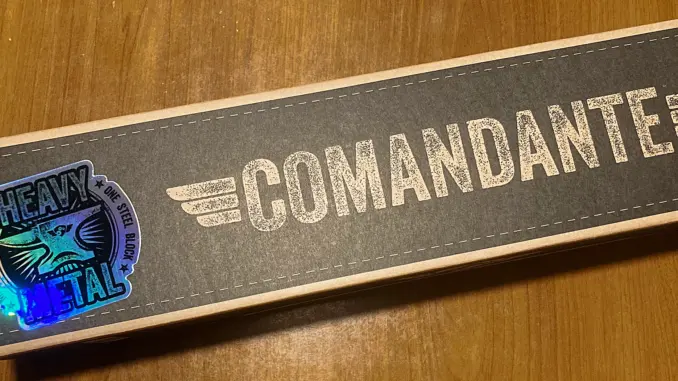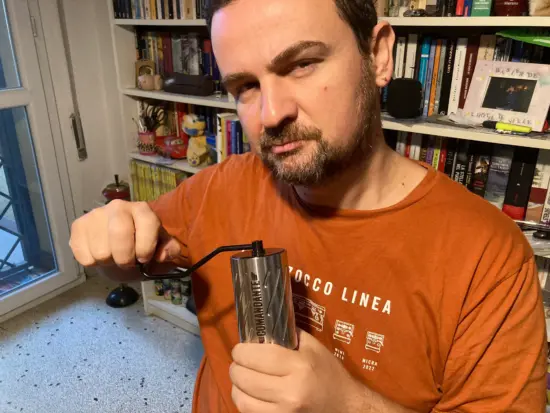
We try out the new C60 Baracuda, with improved burrs and steel body.
BY TANYA NANETTI
SENIOR ONLINE CORRESPONDENT
Photos by Tanya Nanetti
As is the case for many, my daily coffee routine is largely made possible by my coffee grinders. Both are made by the German company Comandante: Mando (nicknamed by me), the lightweight X25, is always set to give a delicious Moka (the first coffee of the day). Negan, my classic C40 MK3, is ready for the next V60.
But even though I am satisfied with my grinders, like many coffee geeks, I am always on the lookout for an interesting upgrade or—better yet—a new edition of the grinder itself! That’s why I couldn’t have been happier when I finally had the chance to try the new grinder released by the Comandante family, the Baracuda C60.
On paper, it’s Comandante’s biggest, boldest, most beautiful (and, let’s face it, most expensive) grinder. It’s milled and crafted from a single block of steel using processes normally reserved for high-performance engine parts to achieve absolute stability during the grinding experience.
I absolutely had to try it out.

Unboxing the Baracuda
The Baracuda comes in the same elegant packaging that distinguishes all Comandante grinders. Stickers on the box read “Heavy Metal” and “milled & crafted—one steel block.”
Inside are the classic components: The body is contained in a smaller box that protects it, which tickled my curiosity even more. Two jars (clear and pink), a brief instruction sheet with recommended grind sizes, a nice sticker, and the classic bracelet are also included. Last but not least, there’s the XL crank and Big Joe knob, which are an upgrade compared to the classic C40 MK3 meant to ensure a smoother grinding experience.

Preparing for the Brew
Finally, it was time to assemble the Baracuda. Even at first glance, once I opened the small box and held the steel body in my hand, I noticed how massive the Baracuda is. It has a harder, eye-catching look, and the burrs look ready to quickly crush even the hardest beans.
If you’re used to the classic C40, just holding this new body provides a completely different experience. It was smooth and pleasant to the touch, but much heavier than what I’m used to. A quick weighing confirmed that the body alone weighs 831g (compared to 417g for the C40). The fully assembled Baracuda achieves a total weight of one kilogram, while maintaining the same dimensions as the classic Comandante.

Then it was time to set the desired grinding size, keeping in mind the new C60’s GX50 Gold Clix system, which has an adjustment of 41.6 micrometers per click. It’s much more precise than the C40; the included leaflet reminded me that I have to count a different (higher) number of clicks to reach the desired sharpening size.
I set the Baracuda to 25 clicks (the suggested minimum setting for brewing a V60), and was curious to experiment with how many grams of coffee the new grinder could hold. With my small Ethiopian beans, I could easily fill it with more than 60 grams of coffee. But remember that the jar on the bottom is the classic one that can hold “only” 40 grams, so it is not very wise to grind more than that at one time.

The Grinding Experience
Then it was time to get serious. I started weighing my usual 30 grams of coffee in both the C60 and C40. I noticed how much easier it was to fill the former than the latter (thanks to the absence of the cross-section at the top where the beans usually bounce). Then I handed over the grinder to my partner, Endri, and got ready with the stopwatch. Our first test would be a speed test, and I would need a strong arm to help me.
In less than 42 seconds, the C60 was empty; it took 74 seconds to empty the C40.
As Endri put it, the Baracuda was “slightly harder to use (physically harder), but you can totally feel its power as it grinds.”
And when my time came to try it, I could only confirm his impressions. You can feel that the Baracuda is powerful, faster, and stronger. The key is in its enhanced burrs, which can grind many more beans at the same time.

The Aftermath
The time finally came to sit down and enjoy the two brews (both delicious). Next, we took the opportunity to spend some time on the last task of the morning: deep cleaning the two grinders.
It was only after disassembling them that I was able to appreciate in all their magnificence the burrs of the C60. Compared to those of the classic C40, they’re bigger and bolder. It’s immediately clear why they are able to crush coffee so quickly and powerfully.
My advice? Read the instructions, especially where it says “sharp edges, handle with care.” Of course, there is no danger in using the grinder. But once it is disassembled for deep cleaning it is a different story, and it is easy to understand—for real—the (sharp) power of the new burrs.
Over the next few days, I decided to use the C60 for our daily brewing, and continued to play around with different grind sizes, doses and recipes. I even tried it for our morning Moka pot.
Every time, the cup came out smooth and clean, with the right amount of sweetness and acidity, and the perfect consistency. I would ask for nothing more from my Comandante.
ABOUT THE AUTHOR
Tanya Nanetti (she/her) is a specialty-coffee barista, a traveler, and a dreamer. When she’s not behind the coffee machine (or visiting some hidden corner of the world), she’s busy writing for Coffee Insurrection, a website about specialty coffee that she’s creating along with her boyfriend.

READ THE LATEST BARISTA MAGAZINE
Out now: It’s the October + November 2023 issue of Barista Magazine! Read for free with our digital edition. And for more than three years’ worth of issues, visit our digital archives here.
Get a hard copy of the magazine through our online store, or start a subscription for one year or two.




